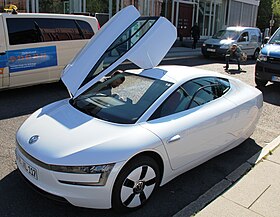Volkswagen XL1
| Volkswagen XL 1 | |
|---|---|

2015 Volkswagen XL1
|
|
| Overview | |
| Manufacturer | Volkswagen |
| Production | 2013– |
| Model years | 2015– |
| Designer | Klaus Bischoff Thomas Ingenlath Peter Wouda M.Missoni |
| Body and chassis | |
| Class | Sports car |
| Body style | Two-door coupé |
| Powertrain | |
| Engine | 800 cc twin-cylinder, common-rail turbo-diesel 35 kW (48 PS; 47 bhp) |
| Electric motor | 20 kW (27 PS; 27 bhp) |
| Hybrid drivetrain | Series Hybrid |
| Battery | 5.5 kWh lithium-ion battery |
| Electric range | 50 kilometres (31 mi) |
| Dimensions | |
| Curb weight | 795 kg (1,753 lb) |
The Volkswagen XL1 (VW 1-Litre) is a two-person limited production diesel-powered plug-in hybrid produced by Volkswagen. The XL1 car was designed to be able to travel 100 km on 1 litre of diesel fuel (280 mpg‑imp; 240 mpg‑US), while being both roadworthy and practical. To achieve such economy, it is produced with lightweight materials, a streamlined body and an engine and transmission designed and tuned for economy. The concept car was modified first in 2009 as the L1 and again in 2011 as the XL1.
A limited production of 250 units began by mid 2013 and pricing starts at €111,000 (~ US$146,000). The Volkswagen XL1 plug-in diesel-electric hybrid is available only in Europe and its 5.5 kWh lithium-ion battery delivers an all-electric range of 50 km (31 mi), has a fuel economy of 0.9 l/100 km (260 mpg‑US; 310 mpg‑imp) under the NEDC cycle and produces emissions of 21 g/km of CO2. The XL1 was released to retail customers in Germany in June 2014.
The prototype VW 1-Litre concept car was shown to the public in April 2002 when Dr. Ferdinand Piech, then Chairman of the Board of Management, drove the concept between Wolfsburg and Hamburg as part of the Volkswagen annual meeting of .
For aerodynamics, the car seats two in tandem, rather than side-by-side. There are no rear view mirrors and it instead uses cameras and electronic displays. The rear wheels are close together to allow a streamlined body. The total aerodynamic drag is minimal because both the drag coefficient and frontal area are small (see drag equation). The drag coefficient (Cd) is 0.159, compared to 0.30 - 0.40 for typical cars.
...
Wikipedia
